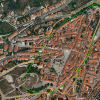A quantitative spatial methodology for delimiting historical centers - an application in Guarda, Portugal
DOI:
https://doi.org/10.5311/JOSIS.2022.25.164Keywords:
historical center, building data, urban boundaries, urban evolution, geospatial statistical analysis, consolidated urban areasAbstract
A historical center can be defined as the oldest part of a city where a significant part of the building stock dates back to the early stages of urban growth. Historical centers often contain special urban fabrics with unique, historic, social and cultural identity. Owing to this, they have been subject to special urban planning interventions in order not only to protect the existing urban fabric and its originality, but also to revert depopulation and built deterioration processes aiming to make these old centers attractive and functional again. However, in the inter-urban domain, there is a deficit of spatial planning research, and the delimitation of historical centers is a topic that has been under explored. This paper describes a morphological approach for delimiting the historical center of Guarda, Portugal. Methodologically, the work uses building stock-age data from eight periods between <1919 to 2011 and is supported by both statistical and spatial analysis. Statistically, the urban evolution of the city was analyzed through threshold values and five novel building indexes. Spatially, the work involved disaggregated GIS analysis to map the evolution of built-up areas and to identify the consolidated urban areas. A sensitivity analysis was also performed to assess the influence of some parameters on the obtained boundary. Results indicated that the historical center of Guarda was consolidated in the 1960s and, since then, has been relatively unchanged. The obtained boundary shows a suitable spatial adjustment considering the consolidated urban area and the official boundary included in the Urban Rehabilitation Area.

Downloads
Published
Issue
Section
License
Copyright (c) 2022 Maria Elisabete Soares, Fernando Fonseca, Rui Ramos

This work is licensed under a Creative Commons Attribution 3.0 Unported License.
Articles in JOSIS are licensed under a Creative Commons Attribution 3.0 License.
